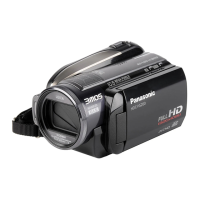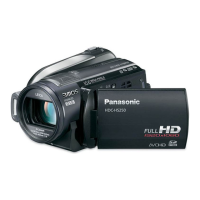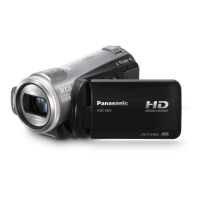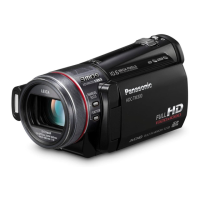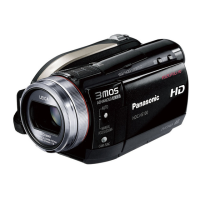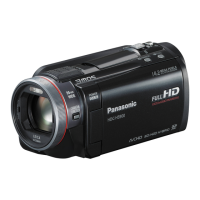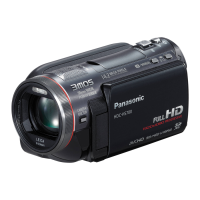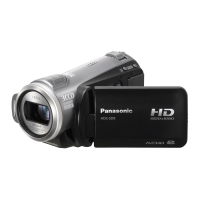Do you have a question about the Panasonic HDC-HS25 and is the answer not in the manual?
Safety precautions for the AC mains lead, plug, and fuse replacement.
Step-by-step instructions for replacing the fuse in the plug.
Warnings about fire, electric shock, product damage, and ventilation.
Warnings regarding battery handling, heat, and disposal.
Information on EMC compliance and recommended accessories.
Information on proper disposal of old equipment and batteries according to regulations.
Information on SD and SDHC memory cards compatible with the unit.
Lists trademarks, licenses, and patent information for the product.
Contact details for customer care, technical support, and product information.
Details on how to inquire about purchasing an extended guarantee.
Lists accessories supplied with the unit.
Lists optional accessories available for purchase.
Describes the high-definition image recording capabilities.
Explains the AVCHD format for recording high-definition images.
Details compatibility with TVs, DVD burners, and PCs.
Instructions for handling the built-in memory of the HDC-TM20 model.
Explains the function and precautions for the access lamp.
Precautions for handling the HDD, including vibration, backup, and temperature.
Explains the HDD access lamp and associated precautions.
Identifies and describes the LCD monitor, buttons, and terminals.
Identifies and describes various camera body parts and features.
Instructions for attaching lens accessories and caps.
Identifies and describes camera controls, grip belt, and tripod mount.
Lists compatible battery models for the unit.
Instructions on how to charge the battery using the AC adaptor.
Step-by-step guide for inserting and removing the battery.
Provides charging and recording time estimates for different battery models.
Explains how battery capacity is displayed and related notes.
Instructions for connecting the unit to the AC outlet for power.
Details on SD and SDHC cards, including speed class and model compatibility.
Step-by-step instructions for inserting and removing SD cards.
Explains the SD card access lamp and associated precautions.
Instructions on how to switch the unit on and off using the mode switch/dial.
How to turn the unit on and off by opening/closing the LCD monitor.
How to operate the unit by touching the LCD screen directly or with the stylus.
Guidance on using and storing the supplied stylus pen.
Explains the function of common operation icons on the screen.
Step-by-step guide to accessing and changing settings via the menu.
How to view and cancel information display settings within the menu.
How to select the display language and overview of menu options.
Options for adjusting picture quality and burst shooting.
Settings for media selection, display, clock, and economy mode.
Configuration for alert sounds, LCD settings, demo mode, and system initialization.
Step-by-step guide to set the unit's date and time.
How to change the date and time display format.
Instructions to change the date display format (Y/M/D, M/D/Y, D/M/Y).
How to set and display time for different travel destinations.
How to adjust LCD brightness for better visibility in bright conditions.
How to adjust the brightness and colour density of the LCD monitor.
Procedure to calibrate the touch screen for accurate input.
How to change picture quality settings (Dynamic/Normal) on the LCD.
How to use the mode for self-recording with a flipped image.
Identifies and explains the functions of the remote control buttons.
Instructions for replacing the battery in the remote control.
Specifies the distance and angle for effective remote control operation.
How to use direction and OK buttons with the remote control.
Guidance on holding the camera and maintaining balance for recording.
Explains automatic scene and effect selection for simplified recording.
How to switch the intelligent auto mode on and off.
Details on auto white balance and auto focus when intelligent auto is off.
How automatic white balance recognizes and adjusts colors.
Explains auto focus behavior and situations where it may not work well.
How the quick start feature resumes recording quickly from standby.
How to reduce the unit's start-up time for recording.
How to choose between built-in memory, SD card, or HDD for recording.
How to start, pause, and manage recording scenes.
Information on AVCHD format compatibility and potential playback issues.
Explains the icons and information displayed during recording.
Details recording modes (HA, HG, HX, HE) and their approximate recordable times.
Reminder to back up data from built-in memory/HDD to prevent loss.
How to use PRE-REC to capture moments before the record button is pressed.
How to use the shooting guide for fast movement indications.
Steps for capturing still images, including focus and exposure.
Explains focus indicators and the focusing area on the screen.
How to select picture quality for still images (High/Normal).
How to record still pictures while recording motion pictures.
Table showing the number of recordable pictures based on size and quality.
How to use the zoom lever and understand digital zoom limitations.
How to use the O.I.S. button to stabilize images and its limitations.
How to set focus and exposure to a subject using touch screen tracking.
Explains target frame behavior and conditions affecting AF tracking.
How to use the video light for illumination and its limitations.
How to display and select operation icons for image effects.
Lists and briefly describes icons like Backlight Compensation, Fade, etc.
Detailed explanation of effects like Backlight Compensation, Fade, Soft Skin Mode, etc.
Further details and usage notes for Intelligent Contrast, Fade, Soft Skin, Tele Macro, and Colour Night View.
How to use scene modes for different shooting situations.
How to use guide lines for leveling and composition.
How to record vivid, movie-like images using digital cinema mode.
How to perform relay recording and use Anti-Ground-Shooting.
How to use auto slow shutter for brighter low-light pictures.
How the camera detects and frames faces for focus and exposure.
How to record with enhanced colour using x.v.Colour™ technology.
How to adjust wind noise reduction and microphone setup (Surround/Zoom).
How to adjust microphone input levels and use AGC.
How to record still pictures continuously at 25 or 50 frames per second.
How to record still pictures using the self-timer.
How to use the built-in flash for recording in dark places.
How to reduce red eye effect and add shutter sound.
Notes on Wind noise reduction, Microphone setup, Hi-speed burst shooting, Self-timer, Flash, and Red eye reduction.
Introduction to manual recording and adjusting settings like white balance, shutter speed, and focus.
How to manually set white balance for accurate color reproduction.
How to manually adjust shutter speed and iris/gain for exposure control.
How to manually adjust focus for sharp images.
How to adjust sharpness, colour, and exposure settings.
How to select media and playback specific scenes.
How to use playback controls like play/pause, fast forward, skip, and slow-motion.
How to change thumbnail display and adjust speaker volume.
Information on fast forward/rewind, skip playback, and slow-motion playback.
How to play back motion pictures frame-by-frame or directly to a specific point.
Information on AVCHD format compatibility and potential playback issues.
How to save a single frame from a motion picture as a still image.
How to create and use a highlight/time frame index for quick scene access.
How to play back motion pictures recorded on specific dates.
How to automatically skip unwanted parts of scenes during playback.
How to play back recorded highlights with added music.
How to select scenes or dates for highlight playback.
How to set playback time and select music for highlight playback.
How to enable repeat playback and resume playback from where it was stopped.
How to select media and playback still pictures.
How to control slide shows and playback operations.
How to adjust slide show interval and music.
Information on JPEG format, DCF standard, and compatibility with other products.
How to play back still pictures recorded on specific dates.
How to delete scenes or still pictures from the media.
Additional notes on stopping deletion, completing editing, and deleting protected/unplayable content.
How to divide a scene to delete specific portions.
How to protect scenes/pictures from accidental deletion.
How to set DPOF data for printing still pictures.
How to check the remaining capacity of SD cards, built-in memory, and HDD.
How to view media information before copying data.
Step-by-step instructions for copying data between media.
Estimated times for copying motion pictures and still pictures.
Important notices regarding disc copying, playback compatibility, and data transfer.
How to perform relay recording and combine scenes from built-in memory and SD card.
Instructions for formatting media, warning about data loss.
How to connect the unit to a TV using various cables.
Explains picture quality based on connection type (HDMI, Component, Video).
How to select the correct TV input channel and troubleshoot display issues.
How to adjust aspect ratio for 4:3 TVs to prevent image squeezing.
How to show or hide playback information on the TV screen.
Explains HDMI connection, resolution settings, and interlace/progressive methods.
How to listen to 5.1 channel sound and connect via component cable.
How to use VIERA Link for linked operations with compatible TVs.
How to control playback and operations using the TV remote via VIERA Link.
Notes on turning the TV and unit power on/off, automatic input switching, and VIERA Link troubleshooting.
How to prepare for copying and playing back discs using a DVD burner.
Lists compatible disc types (DVD-RAM, DVD-RW, DVD-R) for copying.
Steps for connecting the unit to the DVD burner and starting the copy/play process.
Instructions for copying motion pictures and still pictures to discs.
How to select scenes, dates, and start the disc copying process.
Estimates for copying motion pictures and still pictures to discs.
Important notices regarding disc copying, playback compatibility, and data transfer.
How to play back discs that have been copied using the DVD burner.
How to format discs, enable auto protect, and display disc information.
How to dub images from the unit to a DVD recorder or video device.
How to connect the unit to a PictBridge-compatible printer.
How to select media, pictures, number of prints, and date print settings.
How to select paper size and page layout for printing.
How to start printing and handle interruptions or errors during printing.
Overview of actions possible with a PC: data copying, editing, playback, and formatting.
Notes on transferring data, editing, and using HD Writer AE 1.0.
Information on PC requirements and performance for HD Writer AE 1.0.
Step-by-step guide for installing the HD Writer AE 1.0 software.
Instructions for uninstalling the HD Writer AE 1.0 software.
How to connect the unit to a PC via USB cable for data transfer.
Solutions for driver recognition issues and safe USB cable disconnection.
How the unit appears on PC and the folder structure for stored data.
How to copy still pictures to a PC using Explorer.
Steps to launch the HD Writer AE 1.0 software on the PC.
How to find and read the PDF operating instructions for the software.
Information for Macintosh users regarding software and file transfer.
Explains various icons and indicators shown during recording.
Explains indicators for white balance, scene modes, zoom, flash, and more.
Explains indicators for playback operations and PC connection status.
Explains indications for low battery, no SD card, and DVD burner status.
Explains common messages related to data backup, HDD errors, temperature, cards, and batteries.
Explains messages related to data recovery and thumbnail errors.
Lists functions that are disabled or cannot be used together due to unit specifications.
Lists additional functions and their conditions that disable them.
Details conflicts for MF assist, Hi-speed burst, Flash, Shutter sound, White balance, and Iris/Gain.
Solutions for issues like unit not turning on, short battery life, and auto power off.
Solutions for recording not starting, incorrect touch selection, and AF tracking problems.
Solutions for playback problems, color balance, squeezed images, and scene deletion issues.
Solutions for image color/brightness changes, warping, and VIERA Link not working.
Solutions for PC not detecting unit, USB cable errors, and copying issues.
Explains potential issues with scene transitions during playback on different devices.
Explains issues related to scene deletion, copying, and mode changes.
Important cautions regarding heat, electromagnetic interference, and physical handling.
Precautions for use in dusty/sandy environments, cleaning, and avoiding chemicals.
Clarifies that the unit is for consumer use and not for continuous or business applications.
Advice on storing the unit and physically formatting memory/HDD before disposal.
Information on battery life, temperature effects, storage, and preparing spare batteries.
Cautions regarding the AC adaptor, charging, and LCD monitor care.
Explains causes of condensation and how to prevent/handle it.
Lists key specifications like power source, consumption, sensor, lens, and monitor.
Details on HDMI, USB, flash range, dimensions, mass, and operating conditions.
Details on recording media, compression formats, and picture sizes for motion and still pictures.
Technical details for the AC adaptor, including power source and consumption.
Safety precautions for the AC mains lead, plug, and fuse replacement.
Step-by-step instructions for replacing the fuse in the plug.
Warnings about fire, electric shock, product damage, and ventilation.
Warnings regarding battery handling, heat, and disposal.
Information on EMC compliance and recommended accessories.
Information on proper disposal of old equipment and batteries according to regulations.
Information on SD and SDHC memory cards compatible with the unit.
Lists trademarks, licenses, and patent information for the product.
Contact details for customer care, technical support, and product information.
Details on how to inquire about purchasing an extended guarantee.
Lists accessories supplied with the unit.
Lists optional accessories available for purchase.
Describes the high-definition image recording capabilities.
Explains the AVCHD format for recording high-definition images.
Details compatibility with TVs, DVD burners, and PCs.
Instructions for handling the built-in memory of the HDC-TM20 model.
Explains the function and precautions for the access lamp.
Precautions for handling the HDD, including vibration, backup, and temperature.
Explains the HDD access lamp and associated precautions.
Identifies and describes the LCD monitor, buttons, and terminals.
Identifies and describes various camera body parts and features.
Instructions for attaching lens accessories and caps.
Identifies and describes camera controls, grip belt, and tripod mount.
Lists compatible battery models for the unit.
Instructions on how to charge the battery using the AC adaptor.
Step-by-step guide for inserting and removing the battery.
Provides charging and recording time estimates for different battery models.
Explains how battery capacity is displayed and related notes.
Instructions for connecting the unit to the AC outlet for power.
Details on SD and SDHC cards, including speed class and model compatibility.
Step-by-step instructions for inserting and removing SD cards.
Explains the SD card access lamp and associated precautions.
Instructions on how to switch the unit on and off using the mode switch/dial.
How to turn the unit on and off by opening/closing the LCD monitor.
How to operate the unit by touching the LCD screen directly or with the stylus.
Guidance on using and storing the supplied stylus pen.
Explains the function of common operation icons on the screen.
Step-by-step guide to accessing and changing settings via the menu.
How to view and cancel information display settings within the menu.
How to select the display language and overview of menu options.
Options for adjusting picture quality and burst shooting.
Settings for media selection, display, clock, and economy mode.
Configuration for alert sounds, LCD settings, demo mode, and system initialization.
Step-by-step guide to set the unit's date and time.
How to change the date and time display format.
Instructions to change the date display format (Y/M/D, M/D/Y, D/M/Y).
How to set and display time for different travel destinations.
How to adjust LCD brightness for better visibility in bright conditions.
How to adjust the brightness and colour density of the LCD monitor.
Procedure to calibrate the touch screen for accurate input.
How to change picture quality settings (Dynamic/Normal) on the LCD.
How to use the mode for self-recording with a flipped image.
Identifies and explains the functions of the remote control buttons.
Instructions for replacing the battery in the remote control.
Specifies the distance and angle for effective remote control operation.
How to use direction and OK buttons with the remote control.
Guidance on holding the camera and maintaining balance for recording.
Explains automatic scene and effect selection for simplified recording.
How to switch the intelligent auto mode on and off.
Details on auto white balance and auto focus when intelligent auto is off.
How automatic white balance recognizes and adjusts colors.
Explains auto focus behavior and situations where it may not work well.
How the quick start feature resumes recording quickly from standby.
How to reduce the unit's start-up time for recording.
How to choose between built-in memory, SD card, or HDD for recording.
How to start, pause, and manage recording scenes.
Information on AVCHD format compatibility and potential playback issues.
Explains the icons and information displayed during recording.
Details recording modes (HA, HG, HX, HE) and their approximate recordable times.
Reminder to back up data from built-in memory/HDD to prevent loss.
How to use PRE-REC to capture moments before the record button is pressed.
How to use the shooting guide for fast movement indications.
Steps for capturing still images, including focus and exposure.
Explains focus indicators and the focusing area on the screen.
How to select picture quality for still images (High/Normal).
How to record still pictures while recording motion pictures.
Table showing the number of recordable pictures based on size and quality.
How to use the zoom lever and understand digital zoom limitations.
How to use the O.I.S. button to stabilize images and its limitations.
How to set focus and exposure to a subject using touch screen tracking.
Explains target frame behavior and conditions affecting AF tracking.
How to use the video light for illumination and its limitations.
How to display and select operation icons for image effects.
Lists and briefly describes icons like Backlight Compensation, Fade, etc.
Detailed explanation of effects like Backlight Compensation, Fade, Soft Skin Mode, etc.
Further details and usage notes for Intelligent Contrast, Fade, Soft Skin, Tele Macro, and Colour Night View.
How to use scene modes for different shooting situations.
How to use guide lines for leveling and composition.
How to record vivid, movie-like images using digital cinema mode.
How to perform relay recording and use Anti-Ground-Shooting.
How to use auto slow shutter for brighter low-light pictures.
How the camera detects and frames faces for focus and exposure.
How to record with enhanced colour using x.v.Colour™ technology.
How to adjust wind noise reduction and microphone setup (Surround/Zoom).
How to adjust microphone input levels and use AGC.
How to record still pictures continuously at 25 or 50 frames per second.
How to record still pictures using the self-timer.
How to use the built-in flash for recording in dark places.
How to reduce red eye effect and add shutter sound.
Notes on Wind noise reduction, Microphone setup, Hi-speed burst shooting, Self-timer, Flash, and Red eye reduction.
Introduction to manual recording and adjusting settings like white balance, shutter speed, and focus.
How to manually set white balance for accurate color reproduction.
How to manually adjust shutter speed and iris/gain for exposure control.
How to manually adjust focus for sharp images.
How to adjust sharpness, colour, and exposure settings.
How to select media and playback specific scenes.
How to use playback controls like play/pause, fast forward, skip, and slow-motion.
How to change thumbnail display and adjust speaker volume.
Information on fast forward/rewind, skip playback, and slow-motion playback.
How to play back motion pictures frame-by-frame or directly to a specific point.
Information on AVCHD format compatibility and potential playback issues.
How to save a single frame from a motion picture as a still image.
How to create and use a highlight/time frame index for quick scene access.
How to play back motion pictures recorded on specific dates.
How to automatically skip unwanted parts of scenes during playback.
How to play back recorded highlights with added music.
How to select scenes or dates for highlight playback.
How to set playback time and select music for highlight playback.
How to enable repeat playback and resume playback from where it was stopped.
How to select media and playback still pictures.
How to control slide shows and playback operations.
How to adjust slide show interval and music.
Information on JPEG format, DCF standard, and compatibility with other products.
How to play back still pictures recorded on specific dates.
How to delete scenes or still pictures from the media.
Additional notes on stopping deletion, completing editing, and deleting protected/unplayable content.
How to divide a scene to delete specific portions.
How to protect scenes/pictures from accidental deletion.
How to set DPOF data for printing still pictures.
How to check the remaining capacity of SD cards, built-in memory, and HDD.
How to view media information before copying data.
Step-by-step instructions for copying data between media.
Estimated times for copying motion pictures and still pictures.
Important notices regarding disc copying, playback compatibility, and data transfer.
How to perform relay recording and combine scenes from built-in memory and SD card.
Instructions for formatting media, warning about data loss.
How to connect the unit to a TV using various cables.
Explains picture quality based on connection type (HDMI, Component, Video).
How to select the correct TV input channel and troubleshoot display issues.
How to adjust aspect ratio for 4:3 TVs to prevent image squeezing.
How to show or hide playback information on the TV screen.
Explains HDMI connection, resolution settings, and interlace/progressive methods.
How to listen to 5.1 channel sound and connect via component cable.
How to use VIERA Link for linked operations with compatible TVs.
How to control playback and operations using the TV remote via VIERA Link.
Notes on turning the TV and unit power on/off, automatic input switching, and VIERA Link troubleshooting.
How to prepare for copying and playing back discs using a DVD burner.
Lists compatible disc types (DVD-RAM, DVD-RW, DVD-R) for copying.
Steps for connecting the unit to the DVD burner and starting the copy/play process.
Instructions for copying motion pictures and still pictures to discs.
How to select scenes, dates, and start the disc copying process.
Estimates for copying motion pictures and still pictures to discs.
Important notices regarding disc copying, playback compatibility, and data transfer.
How to play back discs that have been copied using the DVD burner.
How to format discs, enable auto protect, and display disc information.
How to dub images from the unit to a DVD recorder or video device.
How to connect the unit to a PictBridge-compatible printer.
How to select media, pictures, number of prints, and date print settings.
How to select paper size and page layout for printing.
How to start printing and handle interruptions or errors during printing.
Overview of actions possible with a PC: data copying, editing, playback, and formatting.
Notes on transferring data, editing, and using HD Writer AE 1.0.
Information on PC requirements and performance for HD Writer AE 1.0.
Step-by-step guide for installing the HD Writer AE 1.0 software.
Instructions for uninstalling the HD Writer AE 1.0 software.
How to connect the unit to a PC via USB cable for data transfer.
Solutions for driver recognition issues and safe USB cable disconnection.
How the unit appears on PC and the folder structure for stored data.
How to copy still pictures to a PC using Explorer.
Steps to launch the HD Writer AE 1.0 software on the PC.
How to find and read the PDF operating instructions for the software.
Information for Macintosh users regarding software and file transfer.
Explains various icons and indicators shown during recording.
Explains indicators for white balance, scene modes, zoom, flash, and more.
Explains indicators for playback operations and PC connection status.
Explains indications for low battery, no SD card, and DVD burner status.
Explains common messages related to data backup, HDD errors, temperature, cards, and batteries.
Explains messages related to data recovery and thumbnail errors.
Lists functions that are disabled or cannot be used together due to unit specifications.
Lists additional functions and their conditions that disable them.
Details conflicts for MF assist, Hi-speed burst, Flash, Shutter sound, White balance, and Iris/Gain.
Solutions for issues like unit not turning on, short battery life, and auto power off.
Solutions for recording not starting, incorrect touch selection, and AF tracking problems.
Solutions for playback problems, color balance, squeezed images, and scene deletion issues.
Solutions for image color/brightness changes, warping, and VIERA Link not working.
Solutions for PC not detecting unit, USB cable errors, and copying issues.
Explains potential issues with scene transitions during playback on different devices.
Explains issues related to scene deletion, copying, and mode changes.
Important cautions regarding heat, electromagnetic interference, and physical handling.
Precautions for use in dusty/sandy environments, cleaning, and avoiding chemicals.
Clarifies that the unit is for consumer use and not for continuous or business applications.
Advice on storing the unit and physically formatting memory/HDD before disposal.
Information on battery life, temperature effects, storage, and preparing spare batteries.
Cautions regarding the AC adaptor, charging, and LCD monitor care.
Explains causes of condensation and how to prevent/handle it.
Lists key specifications like power source, consumption, sensor, lens, and monitor.
Details on HDMI, USB, flash range, dimensions, mass, and operating conditions.
Details on recording media, compression formats, and picture sizes for motion and still pictures.
Technical details for the AC adaptor, including power source and consumption.
| Recording Format | AVCHD |
|---|---|
| Sensor Type | MOS |
| LCD Screen Size | 2.7 inches |
| LCD Screen Resolution | 230, 000 dots |
| Image Format | JPEG |
| Max Video Resolution | 1920 x 1080 |
| Microphone | Stereo |
| HDMI Output | Yes |
| USB Interface | Yes |
| Battery Type | Lithium-ion |
| Type | Camcorder |
| Recording Media | SD/SDHC card, Internal Hard Drive |
| Internal Storage | 120 GB |

